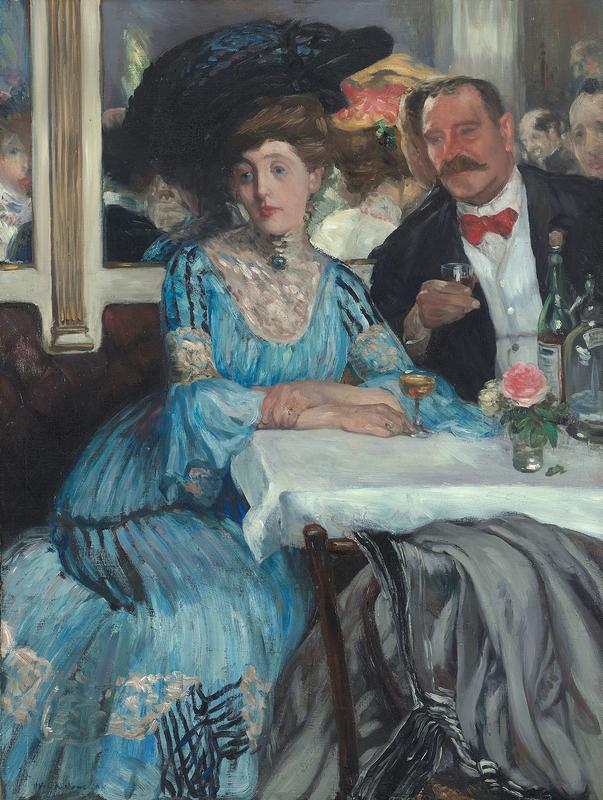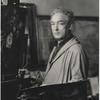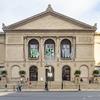More about At Mouquin's

Sr. Contributor
William Glackens loved the glitz and glamour of new leisure activities that took the United States by storm at the end of the nineteenth century.
If that sounds familiar, that’s because Glackens was just transplanting the ideas and techniques of Impressionism into the American art scene. Americans were late to the party, so Glackens had to travel abroad to experience this revelatory new way of painting. In 1895, Robert Henri persuaded Glackens to accompany him on a European trip where Glackens finally got to experience works by his favorite artists. Although he loved seeing works by Rembrandt and Frans Hals, he really fell in love with the city and artists of Paris.
Glackens showed At Mouquin’s at the 1908 exhibition that put "The Eight," a group of artists later known as the Ashcan School, on the map. Although Glackens technically belonged to The Eight, his artwork was nowhere near as gritty and gloomy as theirs was. Instead, Glackens preferred scenes like this one, filled with sumptuous fabrics, strong drinks, and the social elite. At Mouquin’s was a sharp detour in American art. Glackens challenged the stuffy, polished artworks that the National Academy of Design lauded, like those of Thomas Eakins. Instead, Glackens painting recalls Edouard Manet’s bar scenes, like A Bar at the Folies-Bergère.
Instead of appreciating the innovations in technique and subject matter, contemporary Americans were too prude to accept the new direction that Glackens was proposing for painting. Even though Glackens created this painting fifteen years prior to Prohibition, Americans showed their Puritanical roots in their response. Viewers did not see members of the bohemian middle and upper class enjoying an evening at one of their favorite haunts, the New York restaurant Mouquin’s. All they saw was a sensational and vulgar image of vice. People focused on how closely these revelers sat, as well as how they drank alcohol alone, rather than enjoying a libation with dinner.
The characters that Glackens captured in this painting also represent the debauchery that so offended the American conscience. The man featured in this tightly-framed scene is James B. Moore, a prominent lawyer who hung around with artsy types. Moore, a particularly skeezy guy, preferred the company of younger women, whom he enjoyed referring to as his 'daughters.' Moore sits beside a bored Jeanne Mouquin, the restaurant owner’s wife. Jeanne and Henri Mouquin had a rocky and scandalous relationship that shocked Americans. In 1900, Henri had local newspapers report that Jeanne had been having an affair with the man who managed the family’s suburban chicken farm that supplied poultry for their restaurants. After the story broke, Jeanne leaked the news that Henri had had his own affair with the family’s maid when they lived in Hoboken. Though Henri denied having any extramarital relationships, the couple divorced the following year.
Sources
- Elizabeth Thompson Colleary. “Highlights from The William J. Glackens Collection in NSU Museum of Art Fort Lauderdale.” NSU Art Museum. https://nsuartmuseum.org/wp-content/uploads/2015/02/commentaries-works-…. Accesse
- Mouquin History. “Chez Mouquin.” Blogspot. 8 August 2020. https://history.mouquin.com/2020/08/chez-mouquin.html. Accessed 21 December 2020.
- NYPL Labs. “Mouquin Restaurant and Wine Co.” Menus. The New York Public Library. http://menus.nypl.org/menu_pages/4307/explore. Accessed 21 December 2020.
- Shorpy. “Mouquin’s: 1910.” Photo galleries. Places. NYC. https://www.shorpy.com/node/5552#comment-55485. Accessed 21 December 2020.
- The Art Institute of Chicago. American Art. Department of Museum Education, Division of Teacher Programs Chicago: The Art Institute of Chicago, 2008. https://www.artic.edu/assets/f85bee6b-d18b-5577-a9e6-f429421b4654. Accessed 21 December 2020.
- The Art Institute of Chicago. “At Mouquin’s.” The Collection. https://www.artic.edu/artworks/15401/at-mouquin-s. Accessed 21 December 2020.
- The Art Story. “William Glackens Artworks.” Artists. https://www.theartstory.org/artist/glackens-william/artworks/. Accessed 21 December 2020.












I like this painting because the artist did such a great job at painting the reflections in the mirror.